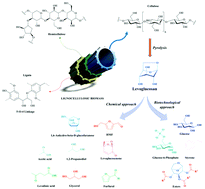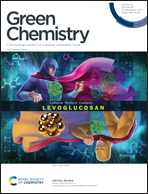Levoglucosan: a promising platform molecule?
Abstract
Lignocellulosic biomass is the most abundant carbon source and it is a base of the whole biorefinery concept. Levoglucosan (1,6-anhydro-β-D-glucopyranose) (LG) is an anhydrous sugar formed as a major product during pyrolysis of cellulose. LG might be a promising chemical platform. It can be converted to different high added-value chemicals such as levoglucosenone, 5-hydroxymethylfurfural and styrene directly or through a glucose intermediate via chemical, catalytic and biochemical processes. In this critical review we focus not only on the pyrolytic methods for the synthesis of levoglucosan, but above all also on the recent scientific progress in the chemical and biochemical transformation of levoglucosan to highly valued compounds. The catalytic performances of the heterogeneous and enzymatic catalytic systems used for different reactions of LG conversion are reviewed. Specific properties of the active sites, roles of additives, and solvents and conditions are discussed in detail. We conclude on recommendations to further improve LG conversion to high added-value products.



 Please wait while we load your content...
Please wait while we load your content...